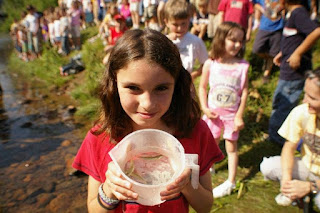Trout in the Classroom officially kicked off its 7th season in Southern Virginia as 30 bundles of tiny, pink, Brown Trout eggs were delivered to some very excited local students.
Arriving at the Wytheville State Hatchery in the early morning hours, Krista Hodges and Brian Williams of the Dan River Basin Association met Hatchery manager Butch Bates to pick up the precious cargo. First stop was a trip outside where we got to see the big breeder browns that are the parents to the eggs we would be getting. Its always exciting to see these big browns and know that what those tiny pink eggs are capable of growing into !
Krista watches the big browns in the outdoor raceway
A big breeder brown trout
We began the process of carefully packaging the tiny bundles for delivery to their new homes in schools across Patrick, Franklin, Henry and Pittsylvania Counties where over 1000 students are participating in the program this season. First the eggs are removed from the brood trays.
Next they are transferred to a holding tank and onto a countertop to be counted out and wrapped in cheese cloth bundles of 200 - 225 eggs in each bundle.
Trout in the Classroom (TIC) was established in Virginia in 2005 by local orthodontist Dr. David Jones and under the direction of the Dan River Basin Association with funding from the Harvest Foundation, and other sources, TIC in Southern Virginia has grown to include around 30 tanks in 4 counties each year. The program has also developed statewide under the direction of the Virginia Trout Unlimited State Council and currently there are 180 tanks in schools across the state.
“The students and teachers really light up as soon as they find out their eggs have arrived!” says Krista Hodges, Education Outreach Coordinator for DRBA. The trout eggs are carried inside of a cheese cloth bundle containing around 200 eggs, which is opened up to be passed around for the students to see.
“The students and teachers really light up as soon as they find out their eggs have arrived!” says Krista Hodges, Education Outreach Coordinator for DRBA. The trout eggs are carried inside of a cheese cloth bundle containing around 200 eggs, which is opened up to be passed around for the students to see.
Many of the students want to know what the dark spots are and why some of them are a different color. The eggs are called “eye-ups” at this stage and have dark spots that can be seen in the center which are their developing eyes. As the students watch closely, some movement can be seen within the egg as the tiny trout wiggle around. The movement is a sign that the students should be seeing some hatching before they leave for break.
Some eggs are white and have to be removed as those may not have been fertilized and will not hatch, and that is part of the care the teachers and students have to provide, removing bad eggs, just like the adult trout would in the wild.
You can tell the students, teachers and other staff involved have become interested in the tiny eggs when they go from saying “slimy fish eggs” to “hey, this is pretty cool!” Trout in the Classroom is an intriguing and exciting program because an instant connection is made with these tiny pink packages that soon will be hungry little trout swimming around the student’s tanks, waiting to be fed.
The students learn how to take care of the trout and provide them a healthy environment to grow over the next six months and they soon realize these guys won’t survive without their help. The program focuses on clean water and healthy rivers and teaches the students the importance of trout as an indicator species in our streams. The students also know they will not be able to keep the trout forever so they learn what it takes to keep them alive and healthy after they are released into the rivers, like clean water and a balanced ecosystem. The program is not only exciting for the students but it also instills a conservation ethic where they learn good stewardship and what it takes to keep their own local waterways and environment clean forever.
The students learn how to take care of the trout and provide them a healthy environment to grow over the next six months and they soon realize these guys won’t survive without their help. The program focuses on clean water and healthy rivers and teaches the students the importance of trout as an indicator species in our streams. The students also know they will not be able to keep the trout forever so they learn what it takes to keep them alive and healthy after they are released into the rivers, like clean water and a balanced ecosystem. The program is not only exciting for the students but it also instills a conservation ethic where they learn good stewardship and what it takes to keep their own local waterways and environment clean forever.






























